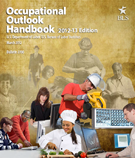|
|
September 27, 2012
Average annual expenditures per consumer unit rose 3.3 percent in 2011, the first yearly increase in spending since the 1.7-percent rise from 2007 to 2008. The rise in spending in 2011 barely outpaced the 3.2-percent increase in prices for goods and services from 2010 to 2011, as measured by the average annual change in the Consumer Price Index (CPI-U).
Full Text »
Recent TED articles

|
Disability, employment, and income: are Iraq/Afghanistan-era U.S. veterans unique?
Jennifer Tennant
Summary |
Full text in PDF
Gulf Coast unemployment trends, 2000–2010: hurricanes, recessions, and oil spills
John A. Coughlan
Summary |
Full text in PDF
Updated BLS Occupational Injury and Illness Classification System
Joyce M. Northwood, Eric F. Sygnatur, and Janice A. Windau
Summary |
Full text in PDF
The football lockout of 2011
Paul D. Staudohar
Summary |
Full text in PDF
|
The Consumer Price Index (CPI) is an estimate of the average change in prices over time paid by urban consumers for a market basket of consumer goods and services in the United States. The CPI is used extensively in many different ways: to adjust historical data, to escalate federal payments and tax brackets, and to adjust rents and wages. It directly affects the lives of Americans, so it must be as accurate as possible. But how accurate is it?
Read full article | Download PDF
Benefit Cost Concepts and the Limitations of ECEC Measurement
Recent Chartbooks
Archived Chartbooks
- Chartbook: Occupational Employment and Wages, May 2009
- Fatal Workplace Injuries in 2006: A Collection of Data and Analysis
- Occupational Injuries and Illnesses: Counts, Rates, and Characteristics, 2006
- A Chartbook of International Labor Comparisons (2010 Edition) (PDF)
- Employment and Wages, Annual Averages 2008
- Charting the U.S. Labor Market in 2006
- Fatal Workplace Injuries in 2005: A Collection of Data and Analysis
- Occupational Injuries and Illnesses: Counts, Rates, and Characteristics, 2005
- Chartbook: Occupational Employment and Wages, May 2008
- Employment and Wages, Annual Averages 2007
- Occupational Injuries and Illnesses: Counts, Rates, and Characteristics, 2004
- Fatal Workplace Injuries in 2004: A Collection of Data and Analysis
- Chartbook: Fatal Occupational Injuries in the United States, 1995-1999
- Regional Economic Patterns in the United States, 1990-1999
- Working in the 21st Century
Copyrights and BLS Publications
- The Bureau of Labor Statistics (BLS) is a Federal government agency and everything that we publish, both in hard copy and electronically, is in the public domain, except for previously copyrighted photographs and illustrations. You are free to use our public domain material without specific permission, although we do ask that you cite the Bureau of Labor Statistics as the source.
- The public domain use of our materials includes linking to our website. You do not need to obtain special permission from the BLS to link to our site.
BLS Emblem

|
- The BLS emblem, and its variations, which are displayed on the BLS website, as well as on BLS publications and other BLS products, are federally registered trademarks. Unauthorized use of the BLS emblem is prohibited. All rights reserved.
|
Test your knowledge
-
Complete the statement with foreign born or native born:
In 2011, there were 24.4 million foreign-born persons (persons who reside in the United States but who were born outside the country or one of its outlying areas to parents who were not U.S. citizens) in the U.S. labor force. The unemployment rate for the ____________ was 9.1 percent in 2011; the jobless rate of the ____________ was 8.9 percent. Overall, the unemployment rates of the ____________ in younger age groups (ages 16 to 34) tend to be lower than the jobless rates for the ____________. Among older workers (ages 35 and up), unemployment rates of the ____________ tend to be higher than for the ____________.
Hint:
Employment status of the foreign-born and native-born by age, 2011.
-
Complete the statement with the correct occupations from the list:
In 2011, women accounted for 47 percent of all employed persons 16 years of age and older. The share of women in specific occupations varied: 14 percent of ____________ and 34 percent of ____________ were women, whereas 61 percent of ____________ and 82 percent of ____________ were women.
- accountants and auditors
- architects and engineers
- elementary and middle school teachers
- physicians and surgeons
Hint:
Women as a percent of total employed in selected occupations, 2011.
More Quiz questions »
|



